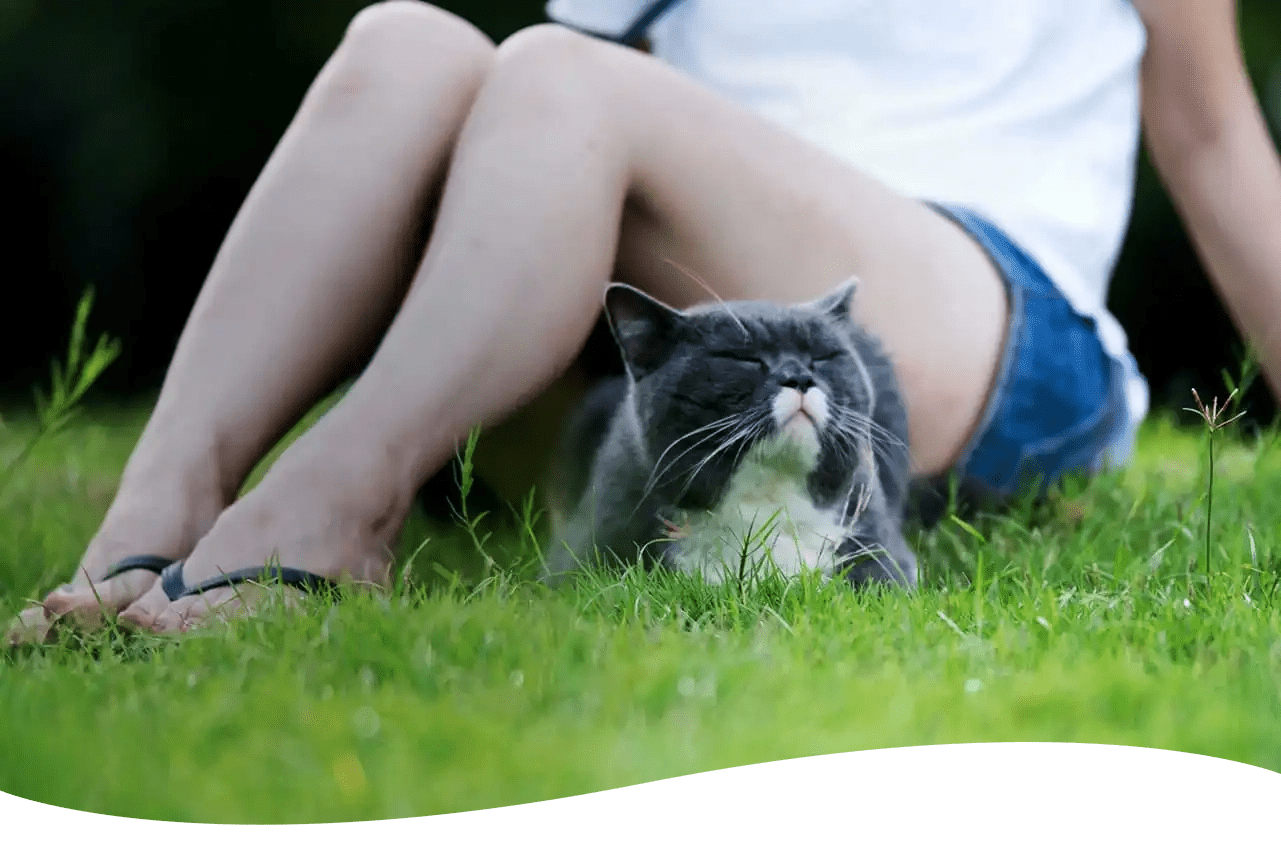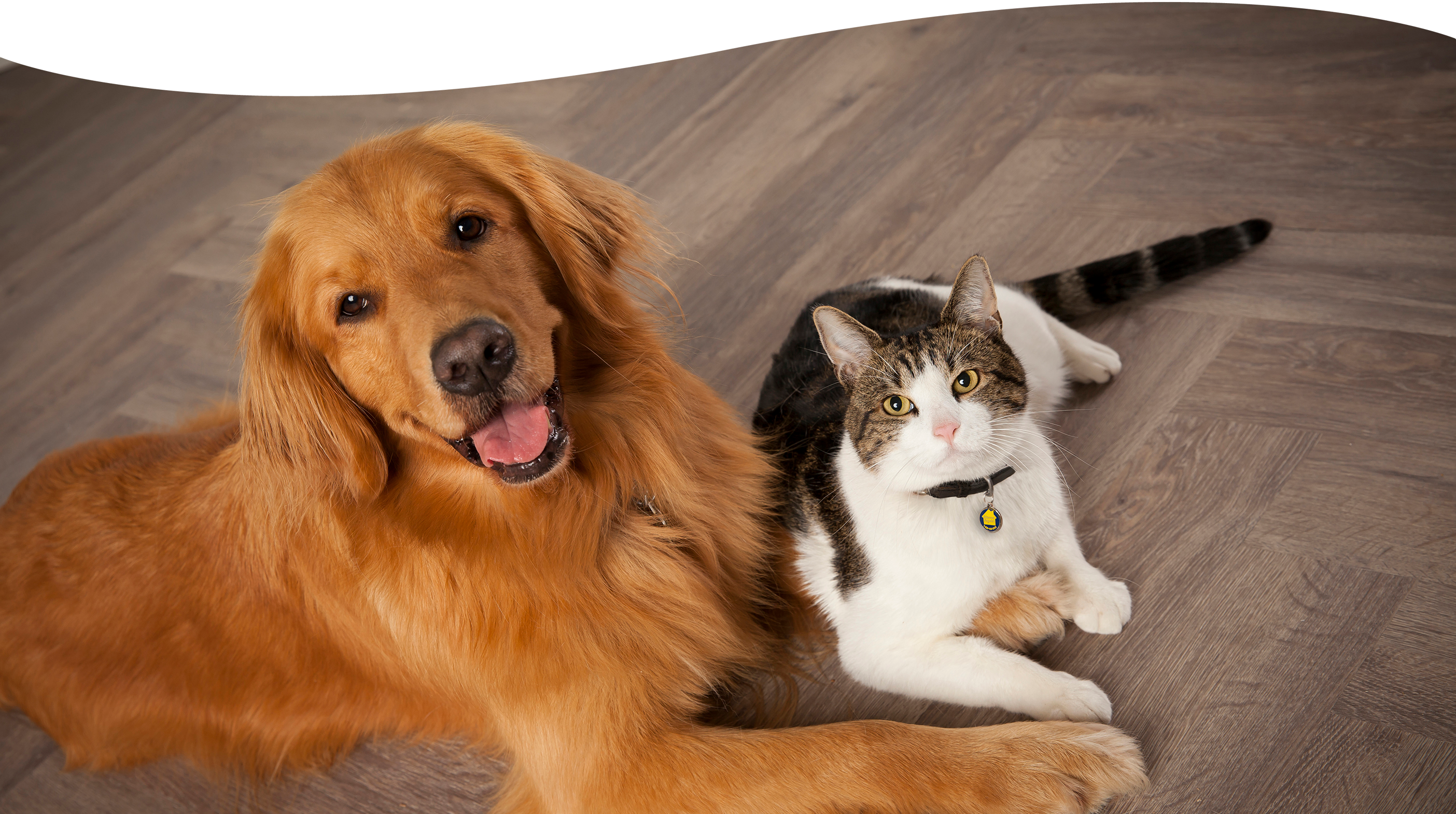

Vetsulin® (porcine insulin zinc suspension)
FAQs for Cats
Vetsulin® Frequently Asked Questions

DIABETES MELLITUS IN CATS
A. Diabetes mellitus (sugar diabetes) occurs when a cat has inadequate levels of or an abnormal response to insulin, which results in excessive glucose (sugar) in the blood.
Diabetes mellitus can develop from disorders of the pancreas, from other diseases, or from the presence of other hormones.
A. No. Diabetes insipidus, also known as water diabetes, is caused when large amounts of dilute urine are produced. It is a far less common condition than diabetes mellitus, known as sugar diabetes. Diabetes insipidus is caused by problems in part of the brain or in the kidneys. There is no glucose present in the urine of animals with diabetes insipidus.
A. The most common signs of diabetes mellitus in cats are:
- Increased thirst
- Excessive urination
- Excessive appetite
- Weight loss despite good appetite
- Lethargy
- Failure to groom; dry, dull fur
A. Polyuria is the production of larger than normal amounts of urine in a given period. Polydipsia is excessive thirst. Polyphagia is excessive hunger.
A. No, your cat could have a bladder or kidney infection, or some other medical problem. If your cat is having problems holding his or her urine, you should schedule a trip to your veterinarian as soon as possible.
A. Your veterinarian will measure your cat’s blood glucose and test your cat’s urine for the presence of glucose and ketones. Persistently high blood glucose levels along with glucose in the urine usually means that your cat has diabetes mellitus.
A. Cats of all ages can get diabetes. Diabetes most typically occurs in older cats. Obesity, genetics, and other conditions can contribute to the development of diabetes.
A. The most common problems associated with pet diabetes include recurrent infections and neuropathy in cats. Diabetic neuropathy in cats usually appears as a weakness in the hind legs. Prompt, appropriate treatment of the diabetes and the hyperglycemia will often reverse the condition.
A. Other diseases that have the same signs of diabetes are:
- Diabetes mellitus
- Cushing’s syndrome
- Bladder infection
- Diabetes insipidus
- Kidney insufficiency
A. No. Diabetes is due to inadequate insulin production or resistance to insulin production. Obesity is a common cause of insulin resistance in cats, as well as humans.
A. Insulin is produced by the beta cells in the pancreas. Type 1 diabetes is due to the destruction of the beta cells with progressive and eventual complete loss of insulin secretion. This type always requires insulin therapy. Type 2 diabetes is characterized by dysfunctional beta cells (irregular insulin production) or the other cells of the body not responding to insulin properly. Type 2 diabetes may or may not require insulin therapy. Cats can fall under the Type 1 or Type 2 classifications.
A. With a recent shift in care for cats with diabetes, studies suggest that if a cat is monitored, and does not have any other health problems, life expectancy can be on par with other cats without diabetes. Unlike dogs, some cats may go into remission with the proper therapy and a controlled diet.
A. Yes, it is very similar. Your cat will be using similar medications, equipment, and monitoring methods as human diabetics use, though treatment goals may be different.
VETSULIN®
A. The first insulin approved by the US Food and Drug Administration for treating both canine and feline diabetes mellitus. Vetsulin is produced by Merck Animal Health and is available only by prescription.
A. No, Vetsulin is registered in over 30 other countries as Caninsulin®. It was first registered in Australia in 1990, so there is a history of more than 25 years of safety and efficacy with this product.
A. No, Vetsulin is manufactured by Merck Animal Health in Germany.
A. No. If Vetsulin is diluted the dosage of insulin would be wrong.
A. Vetsulin is a suspension of two insulin types – an aqueous and crystalline part. Shaking is the best way to make sure these are properly mixed and that your cat receives the right amount of insulin.
A. No, use of a syringe other than a U-40 syringe will result in incorrect dosing and it could be fatal.
A. Vetsulin is an intermediate-acting form of insulin. In cats, the peak activity following dosage occurs about 4 hours after2, and the duration of activity varies between 8 and 12 hours. This is why Vetsulin is prescribed twice daily rather than once daily in cats.
A. Injections should be given subcutaneously (under the skin) about 1 to 2 inches below the spine. Constantly vary the injection location from behind the shoulder blade to just in front of the hip bone, and alternate injections between your cat’s left and right sides. Your veterinarian can show you the recommended locations for injections.
Download the Administration Sheet for instructions on how to give Vetsulin to your cat.
A. No, freezing will damage the insulin molecules and reduce the efficacy of the product. If a vial of insulin accidentally freezes in the refrigerator, it should be discarded and a new vial should be used.
A. Ideally, Vetsulin should be stored upright, protected from light, between 2°C and 8°C (35°F and 46°F). Vetsulin should always remain refrigerated. If you accidentally leave a vial out of the refrigerator, contact your veterinarian for instructions.
A.
- Always have a spare vial on hand
- Protect it from light
- Keep it refrigerated
- If it has gotten too hot, or frozen, discard it immediately
- Discard contents after 42 days of the first vial puncture
- Before drawing up a dose, shake the vial thoroughly until a homogeneous, uniformly milky suspension is obtained
A. The guidelines for each community are different. You will need to check with your own. All syringes should be disposed of in an appropriate sharps/biohazard container.
VETPEN®
A. While insulin pens have been commonly used in the management of human diabetes for some time, VetPen is the first device designed for use in cats with diabetes. Previously, the only approved way to give Vetsulin injections was to use vials and syringes, which some pet parents found inconvenient and overwhelming. While human insulin pens are used to give insulin with a concentration of 100 IU per mL, VetPen works specifically with 40 IU per mL Vetsulin, which is tailor-made for use in pets.
A. VetPen is ergonomically designed to make handling easy and the dosing process simple. It also reduces the time it takes to prepare and give insulin injections. It’s easy enough to use even for pet parents with poor eyesight, arthritis, or any other condition that may cause unsteady hands.
A. The all-in-one construction of VetPen allows you to take it with you while away from home and makes it easy for you to give your pet her insulin nearly anywhere. The VetPen Starter Kit includes a handy travel pouch that holds the VetPen, needles, needle remover, and insulin, as well as the Dose Selector Adaptor and Release Button extensions.
A. VetPen uses 29 gauge, 12mm pen needles only, which are small, thin, and specially lubricated. These are the only needles that should be used with VetPen. Always use a new needle for each injection.
A. A new needle should be used with each injection. The needle should be removed with the needle remover and safely disposed of immediately after use. Reusing a needle may lead to insulin contamination, needle blockage, and/or inaccurate dosing.
A. Yes. VetPen uses a replaceable insulin cartridge that allows multiple doses to be provided with minimal preparation time. When all the insulin has been used, simply remove the empty cartridge and insert a new one. After inserting a new cartridge, it is important to prime the VetPen prior to use. (See instructions for Priming the VetPen)
A. VetPen has been designed specifically for use with Vetsulin. To avoid dosing errors, other types of insulin cartridges for other types of insulin should not be used with VetPen.
A. VetPen helps enhance use by:
- Lowering the risk of accidental needle stick injuries
- Protecting the insulin cartridge from breakage
- Reducing the likelihood of insulin spills
- Reducing air bubbles that lead to inaccurate dosing
- Selecting doses more accurately
A. It is important to confirm that the VetPen and the needle are working properly to ensure that the pet receives an accurate dose of insulin. To do so, measure a small dose and ensure that the insulin flows freely through the needle.
A. Each cartridge contains 2 glass beads to help with the mixing of the Vetsulin before use. The cartridge should be thoroughly shaken before inserting it into the VetPen. After shaking, the insulin should appear uniformly milky. Do not use the cartridge if clumps persist after shaking thoroughly. Do not mistake the glass mixing beads for air bubbles, which should be removed during priming.
A. To make sure the pet’s dose is injected precisely and accurately, you need to hold down the release button until the arrow (►) points to the start line (–) on the dose selector. Then, wait at least 5 seconds before removing the needle from the skin. This allows for VetPen’s internal mechanism to optimally deliver the selected dose.
A. You can tell how many units of the dose were not given by looking at the number where the dose selector stopped. You may need to give the remainder of the dose. If so, write that number down.
Put in a new cartridge, prime (remove air from cartridge), and prepare the VetPen for use. Then, turn the dose selector to the number you wrote down and inject the pet as usual.
A. VetPen should always be stored or carried with the needle removed and the cap on. To clean VetPen, simply wipe with a damp cloth. Do not immerse it in water. Keep Vetsulin cartridges refrigerated and protected from light prior to use. Do not freeze.
A. If you are experiencing any issues using VetPen, the first step is to confirm that air was properly removed from the cartridge through priming. If this has been done, check the other Q&As for more troubleshooting help.
A. This may be a sign the needle may have been removed before the injection was completed, and your cat did not receive the full dose. Do not attempt to re-dose your cat until she is due for her next injection.
To make sure your pet receives his or her full dose, be sure to press the release button down fully and hold it until the arrow (▶) points to the start line (–) on the dose selector. Then, to allow the VetPen to deliver the full dose, wait at least 5 seconds before removing the needle from the skin.
A. There are 4 likely causes for this:
- The release button is not fully pushed toward the needle. This can prevent the dose from being released completely. Be sure to push the release button down fully during each injection so that the dose selector can rotate back to the start line. Then, wait at least 5 seconds before removing the needle.
- You’re closing your hand too tightly around the dose selector. This can prevent it from fully rotating back to the start line. Avoid this by holding the VetPen like a pen so that the dose selector is able to rotate freely after the release button has been depressed.
- The needle is blocked. Replace the needle on VetPen with a new one. It is important to use a new needle for each injection for hygiene and safety reasons.
- The cartridge did not have enough insulin for the full dose. If the cartridge is empty, replace it with a new one and complete the priming process.
A. If too high a dose has been selected, it is very important not to try to turn the dose selector back to a lower dose. This can damage or break the VetPen. Instead, release the insulin through the needle into a tissue or swab by pressing the release button. Then select the correct dose.
A. There are 2 likely causes for this:
- The needle is blocked. To fix, replace the needle with a new one. Remember to use a new needle for each injection.
- The cartridge plunger is stuck. To fix this, place the protective cap back onto the needle and unscrew the cartridge holder. Then slide the release button towards the internal plunger and hold it until the arrow points to the start line. Dial 2 units without screwing the device back together, then push and hold down the release button until the arrow points to the start line. Without rewinding the internal plunger, screw the cartridge holder and the VetPen body back together. This should release the cartridge plunger and expel some of the insulin.
MANAGEMENT OF DIABETES
A. If you missed a full or partial dose, it is best to wait until the next insulin dose is required and then continue as normal. A brief period of high blood sugar (hyperglycemia) due to too low an insulin dose is not as dangerous as the possibility of causing low blood sugar (hypoglycemia) by giving too much insulin.
A. Contact your veterinarian and explain the situation. Your veterinarian may recommend feeding your cat extra food. Monitor your cat carefully for signs of low blood sugar (hypoglycemia):
- Hunger
- Restlessness
- Shivering
- Unsteadiness
- Very quiet or sleepy
If you see any of these signs, try to encourage your cat to eat a small meal, or rub some corn syrup on your cat’s gums.
A. The following signs may indicate hypoglycemia:
- Restlessness
- Trembling or shivering
- Unusual movements or behavior
- Unusual quietness or sleepiness
- Loss of consciousness (coma)
If your cat is conscious, you should immediately treat your cat by pouring a small amount of a sugar solution (like corn syrup) onto your finger and then rubbing it onto your cat’s gums. The sugar is absorbed very quickly and your cat should respond in 1–2 minutes. The sugar solution should never be poured directly into your cat’s mouth since there is a risk that the solution will be inhaled into the lungs. Once your cat has responded to the sugar administration and is sitting up, it can be fed a small meal. Once stabilized, your cat should be transported to your veterinarian for evaluation.
A. Stress hyperglycemia is caused when a cat is frightened or stressed. Glucose in the urine is usually absent with stress hyperglycemia because the blood glucose does not stay high for a long enough period to spill into the urine. Stress hyperglycemia does not usually influence the diagnosis of diabetes because the blood glucose level does not stay elevated long enough to cause glucose to spill into the urine.
A. Fructosamine is a type of protein in the blood that can be used to measure glucose control over a longer period. Unlike blood glucose measurements, fructosamine is not affected by stress or the timing of the insulin injection. Your veterinarian may recommend periodic measurements of fructosamine to evaluate how well your pet’s blood glucose level has been controlled over the last few weeks.
A. If your cat has diabetes, and drinking excessive amounts of water, give him/her all it can drink. Your cat’s body is trying to combat the high blood glucose level by expelling the excess sugar out of its body through the urine. Once your cat is regulated, this will subside.
A. If diabetes is left untreated or unregulated it could cause many complications. These include neuropathy, infections, ketosis, and ultimately death.
A. There is no way to put a specific time on it since each cat is different. Sometimes the regulation process will require you to try different insulin dosages, diets, or injection frequencies. Regulation can be achieved sometimes within a month, or other times over a year from when therapy first started. It is very important to work closely with your veterinarian during this process to avoid further complications. Even after your cat is regulated, frequent veterinarian visits will be necessary to maintain good health.
A. Your veterinarian will be the best person to determine your cat’s diet. Ask about appropriate treats your pet could still enjoy!
A. To keep constant from day to day, it is best to use commercially produced rather than homemade foods. Certain high protein, low carbohydrate prescription veterinary diets are a useful adjunct to insulin therapy. If special diets are unavailable, or your cat does not eat the diets, then standard canned cat foods are acceptable.
A. This is where the blood glucose is measured every 2 hours through the day. The cat should be on the same food schedule as at home. For most cats, a 10–12 hour curve is adequate but in some instances a longer curve may be needed. A glucose curve helps you see insulin effectiveness, glucose nadir (the lowest glucose reading), and duration of insulin effect. The insulin dose, frequency of administration and feeding times may be altered based on these results.
A. The results of the curve can be affected by several factors, and measuring the curve at the veterinarian’s office can give an inaccurate portrayal of what is occurring at home. Not eating or stress (causing hyperglycemia) may occur at the veterinarian’s office. It is advised to feed your cat at home, then take samples until the next meal, in case your cat won’t eat at the veterinarian’s office.
In addition, it is not uncommon for curves to vary from day to day because many things can affect blood glucose levels such as appetite, digestion, metabolism, exercise, hormones, stress, etc., even in well-regulated cats. Discuss any inconsistencies in your glucose curves with your veterinarian.
A. Once regulated, a blood glucose curve is done every six months on average. Your veterinarian will advise you on the best frequency for your cat.
GENERAL
A. If your cat is not eating do not give Vetsulin or any other insulin! If your cat has a reduced appetite, consult your veterinarian on how to proceed with insulin injections.
A. It is very important that your cat eats before you give the Vetsulin injection.
A. If healthy and well regulated, most experts recommend every three months, but your veterinarian will recommend what is best for your cat.
A. It is perfectly safe for a cat with diabetes to receive vaccinations. In fact, it is important to help prevent infectious diseases in your diabetic pet, and this annual visit also gives your veterinarian a good opportunity to give your cat a complete checkup. By keeping your cat healthy, there will be fewer fluctuations in his insulin requirements.
A. Normally animals need to have an empty stomach before they are anesthetized. A cat with diabetes that has not been fed needs far less insulin. Your veterinarian will advise you on how much insulin to give your cat before it is admitted, or may wish to give a reduced dose of insulin for you. Usually a cat with diabetes is administered intravenous fluid therapy while under anesthesia. This hydrates the animal when it cannot drink on its own. Apart from needing a reduced amount of insulin and fluid therapy (which is also given to some other animals undergoing anesthesia), your cat is not at any additional risk from anesthesia than a cat without diabetes of the same age.


Talk to Your Vet Today
Find a veterinarian to learn more about pet diabetes, and how cats and dogs can lead a happy, healthy life with proper management.
IMPORTANT SAFETY INFORMATION:
VETSULIN® and VETPEN® are for use in animals only. Dogs and cats known to have an allergy to pork or pork products should not be treated with VETSULIN®. VETSULIN® is contraindicated during periods of hypoglycemia. Animals with severe ketoacidosis, anorexia, lethargy, and/or vomiting should be stabilized with short-acting insulin and appropriate supportive therapy before use. As with all insulin products, careful patient monitoring for hypoglycemia and hyperglycemia is essential. Overdosage can result in profound hypoglycemia and death. Progestogen and glucocorticoid use should be avoided. The safety and effectiveness of VETSULIN® in puppies, kittens, breeding, pregnant, and lactating dogs and cats has not been evaluated. Keep out of reach of children. Avoid contact with eyes. In case of contact, immediately flush eyes with copious amounts of water for at least 15 minutes. Accidental injection may cause clinical hypoglycemia. In case of accidental injection, seek medical attention immediately. Exposure to the product may induce a local or systemic allergic reaction in sensitized individuals. For complete safety information, refer to the product label.

